Introduction
As the electric vehicle (EV) revolution accelerates, choosing the right EV charger becomes paramount for a seamless and efficient charging experience. The diversity of chargers, coupled with various charging standards, can make the selection process seem like a maze. This guide aims to illuminate the path, empowering you to make an informed decision tailored to your electric mobility needs.
Understanding Different Types of EV Chargers
Electric vehicle chargers come in three primary types: Level 1, Level 2, and DC Fast Chargers. Each caters to distinct charging scenarios and user requirements.
1. Level 1 Charger: The Household Ally
Level 1 chargers operate on a standard household outlet with 120 volts, making them the most accessible option for residential charging. While they provide the slowest charging speed, they are convenient for overnight charging, ensuring your vehicle is ready to roll every morning.
2. Level 2 Charger: Accelerating Your Charge
Stepping up the voltage to 240 volts, Level 2 chargers deliver faster charging compared to Level 1. These chargers are prevalent in public charging stations, workplaces, and residential installations, significantly reducing charging times.
3. DC Fast Charger (Level 3): The Express Lane
For rapid charging on the go, DC Fast Chargers reign supreme. Operating at much higher power levels, these chargers can significantly reduce charging times, making them ideal for long-distance travel and quick top-ups.
Charging Standards: Type 1, Type 2, CCS, CHAdeMO, and Tesla charger
Beyond charger types, understanding the charging standards is crucial for compatibility with your electric vehicle.
1. Type 1 Charging Standard
The Type 1 charging standard, also known as SAE J1772, is a charging protocol primarily used in North America and some other regions. It features a single-phase AC charging connector that supports both Level 1 (120 volts) and Level 2 (240 volts) charging. The Type 1 connector is designed for ease of use, with a standard plug and a lock mechanism for secure connections. While it is prevalent in North America, some electric vehicles in other regions may also use the Type 1 standard.
2. Type 2 Charging Standard
The Type 2 charging standard, officially known as IEC 62196-2, is widely adopted in Europe and is becoming increasingly popular globally. Also referred to as Mennekes, the Type 2 connector supports both single-phase and three-phase AC charging, as well as DC charging. Its versatility has contributed to its widespread use in public charging infrastructure. The Type 2 connector is known for its ergonomic design and additional functionalities, making it a standard choice for many electric vehicles manufactured and sold in Europe.
3. CCS (Combined Charging System)
CCS has emerged as a global standard, combining AC and DC charging. Widely adopted in Europe and gaining traction elsewhere, CCS is supported by various automakers, ensuring a broad network of compatible charging stations.
4. CHAdeMO: Pioneering Fast Charging
Developed in Japan, CHAdeMO is another DC fast-charging standard. While not as widespread globally as CCS, it has a robust presence in Asia and is compatible with several electric vehicle models.
5. Tesla Supercharger: Proprietary Excellence
Tesla owners are familiar with the Supercharger network, a proprietary system designed for Tesla vehicles. Renowned for its rapid charging speeds, it's crucial to note that non-Tesla EVs may require an adapter to use these stations.
-
As you embark on your electric vehicle journey, understanding these charger types and standards lays the foundation for choosing the right charger tailored to your needs. In the next sections, we'll delve deeper into assessing your charging requirements, considerations for home charging, and navigating the public charging infrastructure. Stay tuned for insights that will guide you through the maze of EV chargers and empower you to make an informed decision.
Assessing Your Charging Needs
Now that you have a grasp of the charger types and standards, it's time to align your charging choices with your unique lifestyle and driving habits.
1. Determine Your Daily Driving Habits
Assess your typical daily mileage. If your daily commute is short, a Level 1 or Level 2 charger at home might suffice. For longer commutes, especially if you can't charge at work, a faster charger or access to a public charging network becomes crucial.
2. Consider Charging Infrastructure
Evaluate the charging infrastructure around your home and workplace. Access to public charging stations or a robust home charging setup can significantly influence your decision. Understanding your local charging landscape ensures you're never far from a charging point.
3. Evaluate the Impact of Charging Speed
Charging speed plays a pivotal role, especially if you're on the move frequently. For long-distance travel or quick top-ups during errands, having access to fast-charging options like DC Fast Chargers becomes invaluable.
Home Charging Considerations
Home is where most EV owners will do the majority of their charging. Understanding the intricacies of home charging is crucial for a seamless and efficient experience.
1. Installation Feasibility for Level 1 and Level 2 Chargers
Assess the feasibility of installing Level 1 and Level 2 chargers at home. Level 1 chargers typically require only a standard household outlet, while Level 2 chargers may necessitate a dedicated charging station and potentially some electrical upgrades.
2. Electrical Capacity and Potential Upgrades
Before installing a Level 2 charger, check your home's electrical capacity. Upgrading your electrical system may be required to handle the higher voltage. Consulting with a professional electrician ensures a safe and compliant installation.
3. Smart Charging Features and Connectivity
Consider chargers with smart features and connectivity. Smart chargers often allow you to monitor and manage your charging remotely through mobile apps. This not only enhances convenience but also contributes to efficient energy management.
-
Navigating the considerations for home charging sets the stage for a seamless daily charging routine. In the upcoming sections, we'll explore the public charging infrastructure, charger compatibility with your electric vehicle, and crucial cost considerations. Stay with us as we unravel the complexities of choosing the right EV charger for your electric mobility journey.
Public Charging Infrastructure:
While home charging forms the foundation, understanding and navigating the public charging landscape is essential for those times when you're on the road.
1. Research Availability of Public Charging Stations
Investigate the availability of public charging stations in your area. Various online platforms and mobile apps provide real-time information about charging station locations, availability, and compatible charging standards.
2. Identify Compatible Charging Networks
Different charging stations may be affiliated with specific charging networks. Ensure that the public charging stations you plan to use align with the charging standard of your electric vehicle. Compatibility is key to a hassle-free charging experience.
3. Planning Long-Distance Trips and Fast Chargers
If you anticipate long-distance travel, plan your route with accessible fast chargers. DC Fast Chargers, strategically located along highways, enable quick top-ups during road trips. Familiarize yourself with charging networks that offer these high-speed options.
Charger Compatibility with Your EV Model and Standard
Ensuring that your chosen charger aligns with your electric vehicle's charging standard is fundamental to a successful charging experience.
1. Check Vehicle Manufacturer's Recommendations
Refer to your electric vehicle manufacturer's specifications and recommendations regarding charging standards. Understanding the manufacturer's guidelines ensures optimal compatibility and performance.
2. Ensure Compatibility with Your Vehicle's Charging Port
Confirm that the selected charger is compatible with your electric vehicle's charging port. Some vehicles may have specific connectors or requirements, and choosing a charger that aligns with these specifications is crucial for a secure connection.
3. Software Updates and Adaptations
Stay informed about any software updates or adaptations required for your vehicle to integrate seamlessly with the chosen charger. Regularly updating your electric vehicle's software can address potential compatibility issues.
-
As you navigate the public charging landscape and ensure compatibility with your electric vehicle, the next sections will delve into cost considerations, smart features, reliability, and future-proofing your charging solution. Stay tuned for insights that will empower you to make an informed decision when selecting the right EV charger for your electric vehicle.
Cost Considerations
Understanding the costs associated with different chargers and their installations is a crucial aspect of making an informed decision.
1. Comparing Upfront Costs:
Compare the upfront costs of different charger types and brands. While Level 1 chargers are generally more affordable, investing in a faster charger may be justified based on your driving habits and charging needs.
2. Installation Costs for Home Chargers
Factor in potential installation costs for home chargers. Level 1 chargers often require minimal installation, but Level 2 chargers may involve additional expenses, especially if electrical upgrades are needed.
3. Government Incentives and Rebates
Explore government incentives or rebates for EV charger installations. Many regions offer financial incentives to encourage the adoption of electric vehicles and the installation of home charging infrastructure.
Smart Features and Connectivity
1. Exploring Smart Charging Capabilities
Explore the smart features offered by different chargers, including mobile apps, remote monitoring, and scheduling. Smart chargers enable you to monitor your charging sessions, receive notifications, and optimize charging times.
2. Energy Management for Cost-Effective Charging
Understand the energy management features of smart chargers. Some chargers allow you to take advantage of off-peak electricity rates, optimizing charging times for cost-effective and eco-friendly charging.
3. Compatibility with Smart Home Systems
Evaluate the compatibility of chargers with smart home systems. Seamless integration with smart home platforms can enhance the overall efficiency of your home charging setup.
Reliability and Brand Reputation
Choosing a reliable charger from a reputable brand ensures a trustworthy and durable charging solution.
1. Researching Charger Brands
Research the reliability and durability of different charger brands. User reviews and testimonials from other electric vehicle owners can provide valuable insights into the performance of specific chargers.
2. Reading User Reviews
Read user reviews and testimonials from electric vehicle owners who have experience with the chargers you're considering. Assessing real-world experiences can guide you toward a reliable choice.
3. Considering Warranty and Support
Consider the warranty and support options offered by charger manufacturers. A robust warranty and responsive customer support contribute to a positive ownership experience.
Future-Proofing Your Charging Solution
Anticipating future developments in electric vehicle charging technology ensures that your chosen charger remains relevant in the years to come.
1. Anticipating Advancements in Charging Technology
Stay informed about potential advancements in charging technology. The electric vehicle landscape is dynamic, and new technologies may emerge that enhance charging speeds and capabilities.
2. Evaluating Scalability for Future EV Models
Evaluate the scalability of your chosen charger for future electric vehicle models. Ensuring that your charger can adapt to evolving electric vehicle standards and requirements enhances its long-term value.
3. Staying Informed About Industry Developments
Stay abreast of industry developments and upcoming charging standards. Regularly check for firmware updates or new features that manufacturers may release to enhance the functionality of your charger.
Conclusion
In conclusion, choosing the right EV charger involves a comprehensive assessment of your charging needs, understanding charging standards, and considering factors like cost, smart features, reliability, and future-proofing. By navigating these considerations thoughtfully, you empower yourself to make an informed decision that aligns with your electric mobility journey. As the electric vehicle landscape continues to evolve, your chosen charger will play a pivotal role in enhancing your overall ownership experience.


